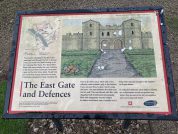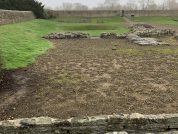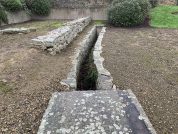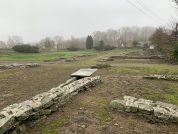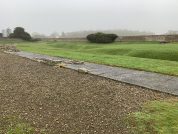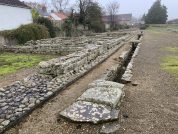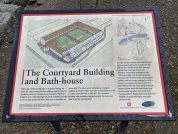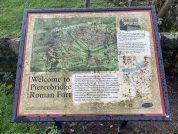Piercebridge (Morbium) Roman Fort
Auxiliary Fort
Piercebridge is located in northern Britain in an area that had been ruled by the Brigantes Celtic Tribe, but which was conquered by the Roman army in the AD 70s. It lies at the point where Dere Street, the main Roman Road that linked York with Corbridge, near Hadrian’s Wall, crossed the River Tees. It would have seen have seen a great deal of military traffic passing between legionary fortress at York and the northern frontier.
1st century Roman Fort at Piercebridge
The existence of a 1st- or 2nd-century Roman fort has been assumed at Piercebridge because of the importance of the site as the point where Dere Street, the Roman road linking York and Corbridge (near Hadrian’s Wall), crossed the Tees. To date, however, no such fort has been found. What is known from this period is the presence of civilian occupation, particularly close to the line of Dere Street in what is now Tofts Field, to the east of the later fort.
Internally the Piercebridge Roman Fort would have comprised of several barracks blocks, granaries, workshops, the headquarters building, and the commandant’s house. The garrison bath house was usually situated outside of the main fort complex.
Late second Century
A major change in the nature of occupation can be seen in the late 2nd century AD when the site became the focus of major military activity, reflected in the material culture. High quality masonry structures were built just to the west of Tofts Field.
3rd century Piercebridge Roman Fort
There is evidence that Roman legionaries were based here in the early 3rd century. Following a military campaign in Scotland during this period many Roman soldiers were involved in rebuilding forts and infrastructure through Northern England and at Piercebridge this work probably included a new bridge across the River Tees and a new base of some kind. This base which included a courtyard building and bath house.
A large fort was built to house auxiliary cavalry in about AD 260 and was occupied until the end of the Roman period. Piercebridge Roman Fort would probably have followed the standard Roman plan, being rectangular in shape with towers at each corner. The early courtyard was probably enlarged at this time and lived in by the commandant, this would have been a deviation from the standard internal layout of a fort.
North of the Courtyard House is the East Gate facing Dere St and probably the most important of the fort’s four gates. In front of the gate was a serious array of ditches, which are still visible.
Further civilian occupation dating from the 3rd century lay south of the river, on either side of the rerouted course of Dere Street (see below), which led to the bridge being built here – see the page on Piercebridge (Morbium) Roman Bridges.
Bath house at Piercebridge
A Roman bath house was still standing at the south-east corner of the fort-site in the 13th century when St Mary’s chapel was built to incorporate part of it: possibly the wall with rounded arched doorway which is still visible from a distance, on private land. In the traditional manner, the garrison bath house stands outside the fort itself. It is a Grade II* listed building and scheduled ancient monument.
5th Century Piercebridge
Despite the importance of the site in the Roman period it soon fell out of use in the early 5th century, once the Romans gave up control of the country. There may have been an Anglo-Saxon settlement in the area, but there is little firm evidence. Unlike many other Roman forts in the north-east it did not end up with a name with the word ‘chester’ in. This was the word Anglo-Saxon’s used to described old forts, particularly Roman ones. This suggests that the purpose of the remains here was not understood by the Anglo-Saxons in the area. Instead, the place became known as Piercebridge, a name first recorded in about 1050. It probably means Percy’s Bridge. The medieval settlement was never very important. It did not have its own parish and had only a small chapel.
Excavations at Piercebridge
Much of the fort now lies beneath later buildings. Excavations in the 1970s, concentrated near the east gate, revealed part of the wall and ditches surrounding the fort, as well as the road that ran around the perimeter inside the defences. Within the fort a large culvert and part of a major courtyard building have been found; the latter was probably the garrison commander’s house. Also visible are the north-east corner of the fort and the fort latrine within it, and some of the buildings of the civilian settlement outside the east gate.
The Epigraphic Evidence from Piercebridge
RIB 1027 - Building inscription of Bellinus
Bellinus.
Huebner wrongly assigned it to Binchester, but corrected it (p. 308)Holder s.v. Bellinus cites several instances of this cognomen.
The Roman Military at Piercebridge
RIB 3258 - Fragmentary tombstone
[To the shades of the dead.. ] of Upper Germany, aged thirty, beneficiarius tribuni of the […Legion, century] of Verus. His most dutiful wife [and …] erected (this) tombstone.
The transcript given here is based upon Hunter, but incorporates conjectures which have been dotted. For the presence at Piercebridge of legionary officers and men from Upper Germany in c. 217, see note to RIB 3253. 3. aetatis anno (with numeral) is the usual formula with aetas, but vixit (or other verbs) annos aetatis is sometimes found, including an instance of the ablative in CIL ix 1994, qui vixit aetate ann. XLV(?). triginta is also used of the age at death in RIB 183. 4. The legion would have been either VIII or XXII, without room for its cognomen, as in RIB 1026. 5–6. For another legionary buried by his coniunx pientissima (unnamed), see RIB 491. 7. [pos]uerun[t] requires a plural subject, so the widow was probably joined by her children, [et fil(ii) pos]uerun[t] or similar. 8. [tit]ulu[m] suits Hunter’s transcript visually as well as vixit or a numeral, and is more likely, since the age at death has already been given. Unless it was centred, a word has been lost to the left.
RIB 1025 - Building inscription of the Sixth Legion
The Sixth Legion Victrix (built this).
No commentary.
RIB 1026 - Funerary inscription for Gracilis (c. A.D. 217)
To the spirits of the departed (and) to … Gracilis, centurion from Upper Germany from the Twenty-Second Legion: Aurelia […]illa had this set up to her husband.
[... ]RACILI
[...]INATO
[...]MAN SVPER
[...]G XXII AVRELIA
[...]ILLA CON
IVGI FACIEND
VM CVRAVIT
It is suggested that Gracilis was a member of a vexillation from leg. XXII Primigenia sent to Britain in the early third century.
RIB 1022 - Altar dedicated to Jupiter Optimus Maximus of Doliche
To Jupiter, Best and Greatest, of Doliche, Julius Valentinus, centurion from Upper Germany, by the god’s order gladly, willingly, and deservedly set this up for himself and his household, in the consulship of Praesens and Extricatus for the second time.
DOLYCHEN[...]
IVL VALENTIN[...]
ORD GER SV[...]
EX IVSSV IPSIVS
POSVIT PRO SE ET
SVIS L L M
[...]AESENTE ET EXTRICATO II CO[...]
No commentary. Addenda from RIB+add. (1995): See JRS lvii (1967), 205 No. 16 (Piercebridge), for another dedication to the same god by legionaries from both Germanies; and Brit. xvii (1986), 438 No. 20 (Piercebridge), a legionary from Upper Germany. The military and political context is discussed by Birley Ep. Stud. iv, 103-7 = Mavors iv, 251-5.
RIB 1024 - Altar dedicated to Mars Condates
To the god Mars Condates, Attonius Quintianus, surveyor, evocatus, gladly fulfilled the command by order.
CONDATI
ATTONIVS
QVINTIANVS
MEN EṾỌC IMP
EX IVS SOL L A
ex cc in l. 5 recorded by Gale, Thoresby, and Horsley, would mean ex ducenario, an officer earning 200,000 sesterces, as Mommsen suggested to Huebner. But this is unusually high pay for a mensor, who was often principalis and sometimes evocatus. For evocatus Augusti mensor see CIL iii 586 (ILS 5947a). Accordingly, Hirschfeld, Kleine Schriften (1913) 635 n. 3 and Fabricius PW s.v. mensor propose the emendation to evoc.As evocatus imp(eratoris) does not appear to be found, it seems necessary to interpret this as imp(eratum) … sol(vit); cf. RIB 2091 (Birrens) R.P.W.For Mars Condates see RIB 731 and 1045.For evocatus see Glossary.
RIB 1023 - Inscription
No translation
[...] M P C C [...]
This conjecture of Dolichenus is not unreasonable.
References to Piercebridge as Morbium
If Piercebridge was the place named Morbium (which is far from certain) recorded in the Notitia Dignitatum – a late 4th- or early 5th-century list of officials and army units in the Roman empire – then the unit listed as the equitatus catafractariorum (heavy cavalry) may have been the mid-4th-century garrison. This takes into account the disputed date of the Notitia and the possibility that its garrison lists for Britain may have been out of date.
Dere Street and the Roman Bridges
There is evidence of two Roman bridges at Piercebridge. The first lay on the original line of Dere Street, below Tofts Field and crossing the grounds of the George Hotel. The evidence for this takes the form of timber piles in the river. These probably supported an entirely timber bridge that seems to have gone out of use near the end of the 2nd century. Before the construction of the Cow Green Reservoir in 1967–71 in Upper Teesdale, the Tees was known for its fierce floods, and it may have been one of these that washed the bridge away.
The second bridge was built with stone piers 180 metres downstream from its predecessor. Its construction necessitated a diversion of Dere Street. It lies on the floodplain of the river and would not have been subject to such intense flooding as the first bridge, which crossed the narrow channel further west.
Finds of pottery associated with buildings along the rerouted southern approach road suggest that the bridge was probably built around the beginning of the 3rd century. It may have remained in use into the medieval period, possibly until the present bridge was constructed in about 1500.
The visible remains lie south of the river and it is known that the Tees has eroded northwards since the Roman period, apparently destroying all evidence of the northern bridge abutment. Nonetheless, the surviving remains suggest that the original structure would have been about 123 metres long.
Other sites near Piercebridge (Morbium) Roman Fort
Piercebridge Roman Fort was the southernmost of four County Durham forts that were constructed along Roman Dere Street, which terminated at Hadrian’s Wall. The other three forts to the north were Binchester, Lanchester, and Ebchester.
Two bowl barrows lie approximately 0.48km to the south of the Site, on Watson’s Hill overlooking the River Tees. These are likely to be the most visible survivors of a wider group of funerary monuments. Barrows of this type date from the Late Neolithic through to the Late Bronze Age with most examples belonging to the period 2400-1500BC. A further barrow lies just 0.9km to the north-west of the Site, on the northern side of the river.
Approximately 5km to the south-west lies the Late Iron Age oppidum of Stanwick (NMR 26950), the substantial earthworks of which enclose an area of 310ha. Excavations on this site show this to have been a major market centre and focus of political power. The site demonstrates continuity of occupation into the early Roman period and the presence of a wealthy elite interacting with the Roman trade routes by the mid 1st century AD. This site later became the location for an early Christian church in the 8th and 9th centuries AD.
Plan of Piercebridge (Morbium) Roman Fort
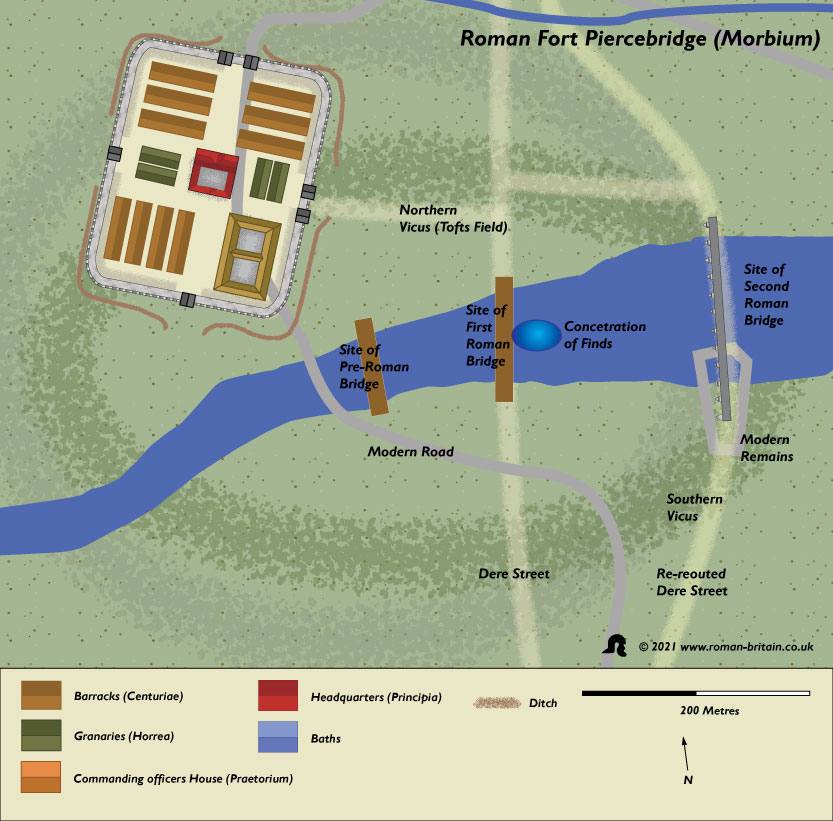
Sites near Piercebridge (Morbium) Roman Fort
- Piercebridge (Moribum) Vicus (0 km)
Vicus - Piercebridge (Morbium) Roman Bridge (0 km)
Roman Bridges - Holme House Villa (1 km)
Villa - Holmes House Roman Fort (1 km)
Trajanic Auxiliary Fort (A.D. 98–117) - Stanwick Camp (5 km)
Iron Age Hillfort - Sandforth Moor Temporary Camp (5 km)
Marching or Temporary Camp - Cleasby Roman Fortlet (6 km)
Fortlet - Carkin Moor Roman Fort (9 km)
Auxiliary Fort - Greta Bridge Vicus (13 km)
Vicus - Greta Bridge Roman Fort (13 km)
Trajanic Auxiliary Fort (A.D. 98–117)
